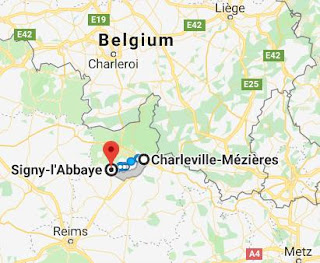An example of the latter concerns the small leaf shown above, in a private collection, than I have looked at periodically since 2000.
I have always found it attractive and unusual, but never attempted to identify the text, and certainly never thought about trying to trace its provenance because, part from the style of the script and decoration, there are no clues from which to start. The quire signature in the middle of the lower margin shows that it was the last leaf of the second quire of the parent volume.
But browsing images recently that I had downloaded from the BVMM (Bibliothèque virtuelle des manuscrits médiévaux) website, I realised that I had found the parent volume, and it turns out to contain some significant provenance information.
The marginal decoration as shown above (not to mention the script, number of lines per page, etc.) is extremely similar to these images, especially the first, of a manuscript now at Charleville-Mézières (Bibliothèque municipale, MS 129), roughly half-way between Reims and Liège:
 |
| [Source] |
 |
| [Source] |
In addition to about a dozen colour images, there is also a complete scanned black-and-white microfilm. From this we can confirm that the last leaf of the second quire is missing.
It must have been separated a long time ago: not only was the leaf missing before the microfilm was made in 1995; it was also missing before the mid(?)-20th-century foliation was supplied; and also before the volume suffered serious water-damage. The single leaf shown at the top of this post is completely free of the water-staining that affects the rest of the volume, all the way through from the front:
to the back:
The point at which the single leaf used to be, between the leaves now foliated as "15" and "16", has water-damage on both sides:
Fortunately the part of the very last leaf of the volume that is least affected by the water-damage, is the part that has a medieval inscription:
 |
| (detail) |
In other words, this is a summary title, followed by shelfmark ("I vi"), and ownership note ("De signiaco").“Excerpta exdiversis pro-positionibus. sacrescriptureI viDe signiaco”
At first sight "Signiaco", Signiacum, looks as if if should refer to Signac, south-west of Toulouse in the Pyrenees, but the verso of the first medieval flyleaf provides extra information:
 |
| (detail) |
“Liber bte Marie de Signiaco Cist. ord.i.e. the St Mary's Cistercian Abbey, Signy, in the diocese of Reims, less than 20 miles south-west of Charleville-Mézières, where the manuscript is now housed:
In Remen. dioces.”
In fact, what I have been referring to as "shelfmarks" above are probably not really shelfmarks at all: they probably do not indicate the shelves or presses on which the books were kept, but are instead class-marks, based on a classification of the manuscripts' contents:
A = the Bible and commentaries on it
B = a continuation of A, plus lives of saints
C = patristics, especially Augustine and Bede
D = Bernard, Gregory, Jerome, et al.
... and so on.
The last letter of the alphabet used, I/J (as in the manuscript discussed above), is difficult to interpret. Only three manuscripts belong to this class, and Bondéelle-Souchier writes "je ne me hasarderai pas à la characteriser".








Thank you Peter - this is fascinating. I followed your linked to the Charleville-Mézières ms (Bibliothèque municipale, MS 129), but couldn't see any access to the catalogue description and I wonder if you know the source for the text on the pages illustrated.. Is it from the Catena aurea, perhaps? Reads to me a little like material for preaching, and I'd like to be able to cite properly the section about the allegorical meaning of 'the mount of Sion'. I also hope that one of these days you'll write a post just about variant forms for page- and quire- and 'shelf'/category marks.
ReplyDeleteThere is a brief description of the MS in the _Catalogue général_, vol. V (1879): https://archive.org/details/cataloguegnralde05fran/page/607
ReplyDeleteThank you again.
ReplyDelete